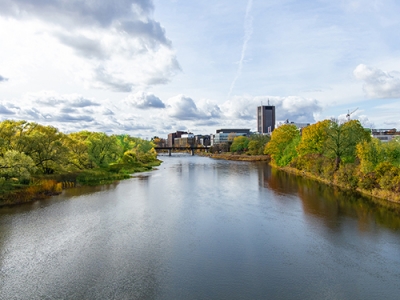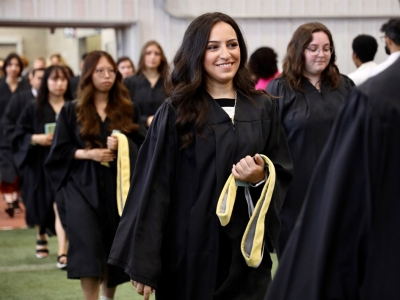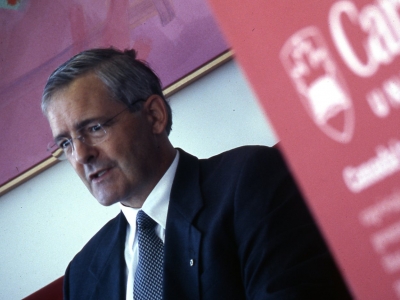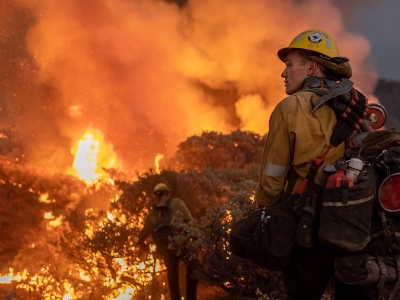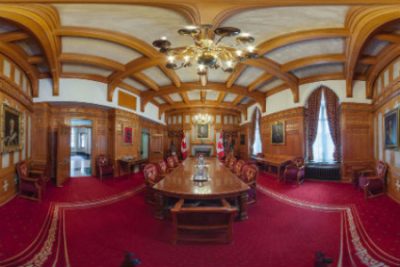 For more than a year, Canadians have been able to explore their upper house of Parliament without physically being there, thanks to a collaboration between the Senate of Canada and the Carleton Immersive Media Studio (CIMS). The Senate Virtual Tour allows anyone — with the swipe of a mouse or the touch of a screen — to wander Centre Block and experience the art and architecture of the Senate Chamber and its surrounds.
For more than a year, Canadians have been able to explore their upper house of Parliament without physically being there, thanks to a collaboration between the Senate of Canada and the Carleton Immersive Media Studio (CIMS). The Senate Virtual Tour allows anyone — with the swipe of a mouse or the touch of a screen — to wander Centre Block and experience the art and architecture of the Senate Chamber and its surrounds.
When rehabilitation work begins on the 100-year-old building and senators move into their temporary home in the nearby Government Conference Centre, the existing chamber will be temporarily shuttered.
Despite this, Canadians will still be able to enjoy its art and architecture on their computers and mobile devices — particularly now that the Senate has launched phase two of its virtual tour. The expanded version includes the Salon de la Francophonie, an elegant meeting room whose décor reflects the 230 years Canada was a French colony, and the chambers of the Speaker of the Senate, a suite of Tudor-inspired reception rooms and offices which is normally off limits to the public.
“The Senate Virtual Tour has always been about inviting Canadians and people around the world to explore the Red Chamber first-hand,” said Senate Speaker George J. Furey. “With this expansion, we are increasing accessibility and sharing more about the history of our Parliament.”
The virtual tour is the work of a unique laboratory within Carleton University’s Azrieli School of Architecture and Urbanism. CIMS specializes in 3-D architectural visualization. Headed by Prof. Stephen Fai, its 30 faculty members and student researchers explore how digital modelling technologies can be harnessed to document heritage buildings, advocate for their rehabilitation and craft immersive digital storytelling experiences that convey the immeasurable value of these historical landmarks.
“One thing that we’ve been doing at CIMS for the last 10 years is taking information we gather from reality capture and trying to figure out how to leverage that information in as many ways as possible,” said Fai. “How do you present not only the architecture and the artifacts but the stories behind them in a way that engages your audience?”
Engineering master’s student and project lead, Abhijit Dhanda, explained the team’s process.
“We create 360-degree panoramas by taking a series of photographs from a fixed point — up, down and at various angles,” he said. “Software finds the common points between photos and stitches them into a circular panorama. It wraps this panoramic image onto the inside of a sphere, creating the illusion that the viewer is at the centre of a globe.”
When it comes to fine details, the expanded tour is smoother and more elegant than ever, thanks to custom coding and the use of fast-loading animation files. Nearly every painting and sculpture is a feature the viewer can explore further. A simple click brings up background information, an image gallery and, in many cases, a 3D animation.
“We created those 3D sculptural pans using photogrammetry,” Dhanda said. “The basic principle is the same as in surveying. You have a camera taking photos from different positions, using triangulation to calculate the distance to each point on the surface. Using multiple photos at different angles, the software is able to compute exact depths and dimensions and create a 3D model.”
PhD student and team lead, Katie Graham, said the project is ultimately about making an iconic Canadian institution accessible to everyone.
“It allows the visitor to see spaces they would otherwise never get to see,” she said. “It’s like an insider’s look at the Senate.”
Media Contact
Steven Reid
Media Relations Officer
Carleton University
613-520-2600, ext. 8718
613-265-6613
Steven_Reid3@Carleton.ca
Carleton Flipboard account: https://flipboard.com/@carletonstories/carleton-stories-0gbu905my
Follow us on Twitter: www.twitter.com/Cunewsroom
Need an expert? Go to: www.carleton.ca/newsroom/experts
Tuesday, May 15, 2018 in Campus News
Share: Twitter, Facebook
